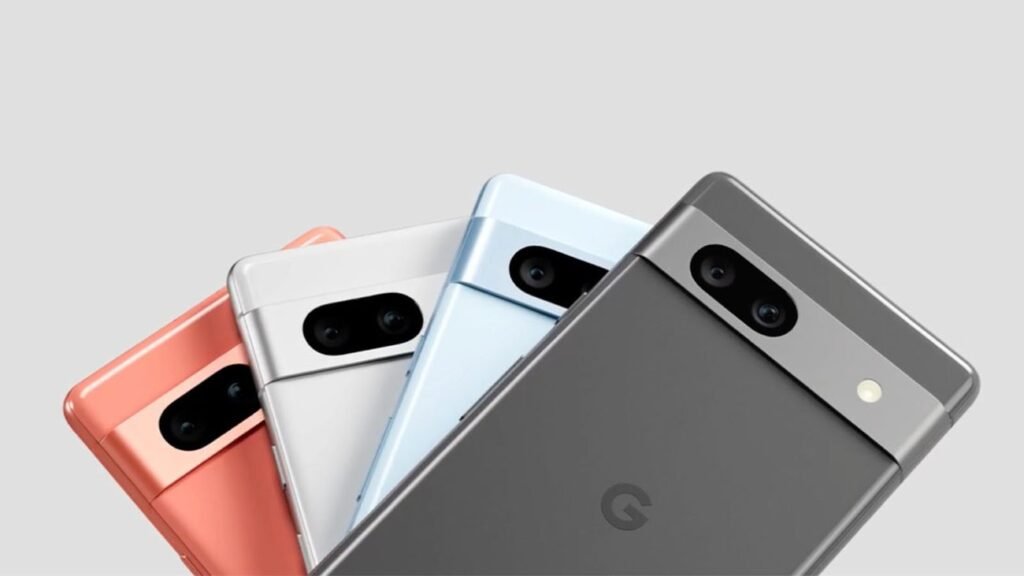Announced at Google I/O in May 2023 and hitting shelves immediately, the Google Pixel 7a marked a significant step up for the “a” series. While its predecessor, the 6a, brought the flagship Tensor chip to the mid-range, the 7a went further, incorporating a high-refresh-rate display, an upgraded camera sensor, and even wireless charging – features typically reserved for Google’s more expensive phones. This ambition, however, came with a slight price increase to $499.
Design: Polished ‘a’ Series

The Pixel 7a fully embraced the design language introduced with the Pixel 6 and refined with the Pixel 7:
- Metallic Camera Bar: It featured the signature metal camera bar stretching across the back, matching the alloy frame and housing the dual cameras in the familiar pill-and-circle cutout.
- Build & Materials: The back was made of a thermoformed composite (plastic), but the overall look and feel, combined with the metal frame and camera bar, felt more premium than previous ‘a’ models. It launched in Charcoal, Snow, Sea (a light blue), and a Google Store exclusive Coral color.
- Durability: It retained the valuable IP67 water and dust resistance rating from the Pixel 5a. The front display used Corning Gorilla Glass 3.
- Familiar Biometrics: The under-display optical fingerprint sensor returned, generally considered improved over the Pixel 6’s launch version. Camera-based Face Unlock was also included for convenient screen unlocking.
- No Headphone Jack: Continuing the trend from the 6a, the 3.5mm headphone jack was absent.
Hardware: Tensor G2 and Premium Upgrades
The Pixel 7a packed impressive hardware for its price point:
- Google Tensor G2: It featured the same powerful Tensor G2 chip found in the flagship Pixel 7 and 7 Pro. This ensured smooth performance, excellent AI capabilities, and access to advanced computational photography features. (Some reports suggested a slightly different chip packaging method compared to the Pixel 7, possibly for cost reasons, but real-world performance differences were minimal).
- RAM Upgrade: RAM was increased to 8GB (up from 6GB on the 6a), matching the standard Pixel 7 and further enhancing multitasking.
- Storage: Came standard with 128GB of fast UFS 3.1 storage.
- 90Hz Smooth Display: A major upgrade! The 6.1-inch OLED display now boasted a 90Hz refresh rate, making scrolling and animations noticeably smoother than the 60Hz panel on the 6a. (This needed to be enabled in settings).
- Wireless Charging Debut: For the first time in the ‘a’ series, the Pixel 7a included Qi-compatible wireless charging (up to 7.5W), adding a significant convenience factor.
- Battery: Housed a 4385mAh battery, offering solid all-day endurance, supported by 18W wired charging.
- Security: Included the integrated Titan M2 security chip.
Cameras: New Sensors, Same Smarts
The Pixel 7a received a significant camera hardware upgrade compared to previous ‘a’ models:
- Upgraded Main Sensor: Moved to a new, high-resolution 64MP main camera sensor (f/1.89, OIS). While physically smaller than the 50MP sensor in the Pixel 7/7 Pro, the higher megapixel count allowed for strong detail capture and improved digital zoom via pixel binning and Google’s Super Res Zoom (up to 8x).
- Improved Ultrawide: The ultrawide camera was also upgraded to a 13MP sensor (f/2.2) with a wider 120° field of view.
- Front Camera: Featured an upgraded 13MP ultrawide selfie camera.
- Tensor G2 Enhancements: The powerful chip enabled flagship software features like:
- Photo Unblur: Sharpen blurry photos (old or new) in Google Photos.
- Magic Eraser, Real Tone, Night Sight, Long Exposure Mode, and excellent Portrait Mode results.
- 4K video recording at up to 60fps.
Software: Android 13 and Beyond
Launching with Android 13 and the Material You interface, the Pixel 7a offered the latest clean Android experience with helpful Pixel-exclusive features. Google promised 3 years of OS updates (until May 2026) and 5 years of security updates (until May 2028).
Reception and Legacy: The Best Pixel Value?
The Pixel 7a was very well-received, often hailed as one of the best mid-range phones available and arguably the best overall value in the entire Pixel lineup at the time. Packing the flagship Tensor G2 chip, a smooth 90Hz display, a significantly upgraded camera system, and adding wireless charging felt like a near-flagship package for $499.
Minor criticisms included the slightly thicker display bezels compared to premium phones, the continued use of older Gorilla Glass 3, and charging speeds that remained at 18W. However, the consensus was that the Pixel 7a offered an outstanding combination of performance, camera quality, and features for its price, making the distinction between Google’s ‘a’ series and its standard flagship model narrower than ever before.
